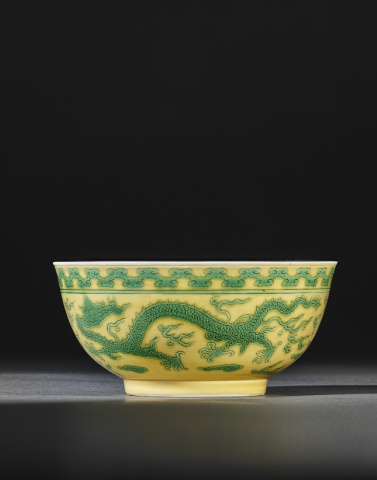Page 169 - Christie's Asia Week March 2024 Chinese Art
P. 169
IMPORTANT CHINESE ART INCLUDING THE COLLECTION OF DOROTHY TAPPER GOLDMAN
(another view)
Another Property
968
A RARE GREEN AND YELLOW-ENAMELED In 1983, several yellow-ground green-enameled vessels decorated with
'DRAGON' BOWL dragons from the Yongle period were unearthed at the Ming imperial
YONGZHENG SIX-CHARACTER MARK WITHIN A DOUBLE-CIRCLE AND porcelain factory archaeological site in Jingdezhen. This discovery
OF THE PERIOD (1723-1735) implies that the prototype inspiring the green and yellow palette and
dragon decoration of the present Yongzheng bowl can be traced back to
5q in. (14 cm.) diam., cloth box
the early 15th century. Only a few Yongzheng mark-and-period dragon
$150,000-250,000 bowls of this design have survived. A Yongzheng bowl with nearly
identical design and size from the Qing Court Collection, is illustrated
PROVENANCE:
The Yiqingge Collection, Japan. by Geng Baochang and Lu Chenglong in The Complete Collection of
Christie's Hong Kong, 1 June 2011, lot 3733. Treasures of the Palace Museum–Miscellaneous Enamelled Porcelains
and Plain Tricoloured Porcelains, Shanghai, p. 119, no. 98. The authors
note that compared to examples from other dynasties, the yellow
清雍正 黃ঃ綠彩雲龍趕珠紋盌 雙१Ս字楷書款
enamel on the Yongzheng bowls is purer, more even and delicate, and
Ϝ源 the color tones are more soft and subtle. Another similar Yongzheng
益清閣珍藏,日本 example, formerly in the Greenwald Collection, is illustrated in G.
香港ωૈ得,2011年6月1日,拍品編號3733
M. Greenwald's The Greenwald Collection: Two Thousand Years of
Chinese Ceramics, 1996, no. 64, and was later sold at Christie’s Hong
The present yellow-ground green-enameled bowl is noteworthy not Kong, 1 December 2010, lot 2828.
only for its strikingly rendered dragons but also for its significant
historical context within the Qing court. The Palace enforced strict
rules and regulations governing the types and quantity of tableware
permissible for use by imperial family members. According to
Huangchao Liqi Tushi (The Illustrated Regulations for Ceremonial
Paraphernalia of the Qing Dynasty), an official encyclopedia
documenting the regulations and hierarchy of utilitarian and ritual
objects at the Qing court, compiled and published by Yun Lu and Jiang
Pu in 1766, vessels adorned with green dragons on a yellow ground were
designated for use by guifei and fei, the emperor's concubines of the
second and third rank.
(mark)
166

